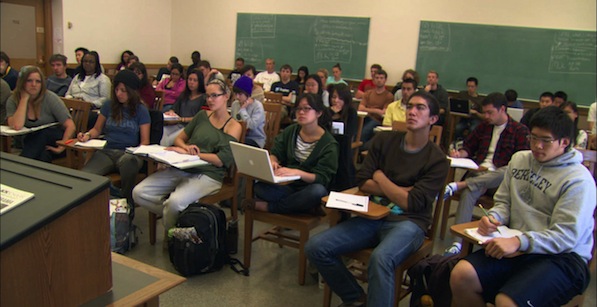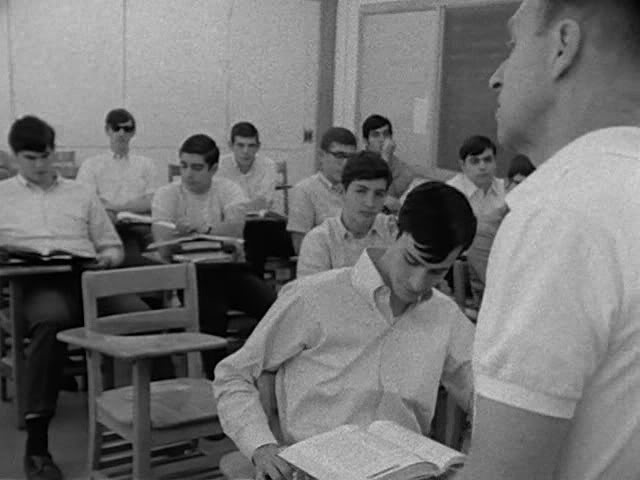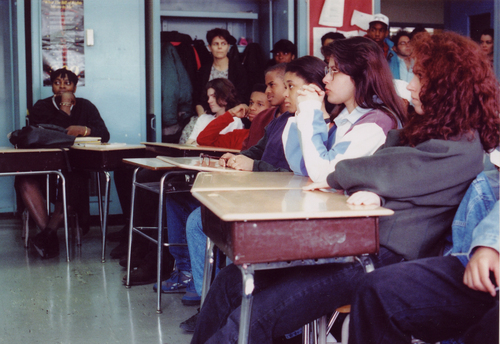For the third time, Frederick Wiseman has gone back to school. The first (and perhaps best known) occurrence was in 1968 with High School, a documentary set in a Pennsylvanian learning institution, which appeared to have a lot in common with a penitentiary. In 1994, he revisited the same subject matter in High School II, examining how this educational setting had changed in the preceding decades. Now he has finally graduated to higher learning, immersing himself in the University of California, Berkeley.
Since abandoning law and turning to filmmaking in 1968 with Titicut Follies, Wiseman has documented institutions as both complex microcosms and mirrors of our society as a whole. His forty-first feature, At Berkeley, opening this week in New York, is one of the larger subjects he has tackled, with its sprawling campus, range of courses and a population of a town. Meticulously constructed through rigorous editing, the four hour-plus film continually builds upon itself, ultimately revealing a telling portrait of the current economic crisis.
During the Toronto International Film Festival, we sat down with Wiseman to discuss selecting Berkeley as an institution, the impact of the presence of a camera on his subjects and the creation of meaning through editing.
Keyframe: Can you talk about the process of selecting Berkeley as an institution?
Frederick Wiseman: I wanted to do a university, and I wanted to do a public university because I thought that would fit into the institutional series I had been doing. Berkeley is one of the best universities in the world, in addition to being one of the great public universities. I simply wrote to the chancellor, who’s the white-haired guy you see in the movie, and he answered right away, saying: ‘Come out and see me.’ I did. I had lunch with him and the provost, and after lunch they said: ‘OK.’ Much to my surprise, I might add.
Keyframe: And that was that?
Wiseman: Yes, and that was that.
Keyframe: Really, they didn’t want to set limits on what and where you could film?
Wiseman: Well, yes. The agreement I had with them was in principal I had access to everything. But if there was a particular event or if one person didn’t want to be photographed all they had to do was tell me. But they had to tell me right away, within forty-eight hours. There was very little I didn’t have access to. I couldn’t shoot tenure discussions, but that was understandable. It’s a very personal discussion and people might not be able to speak their mind about a candidate if they knew I was filming.
Keyframe: It’s interesting that you mention the change in behavior that comes with the presence of the camera. While watching the film, I found myself thinking about how I might react in seminar as a student knowing that Frederick Wiseman was filming me.
Wiseman: I’ve been at this a long time and it’s a question that’s always come up. In my experience, people don’t act for the camera. It’s contrary to the Heisenberg principle, but they don’t; the camera doesn’t seem to affect behavior. What happens is if people don’t want to photographed they say no or walk away. If they agree, well, most people aren’t that good of actors. Being a documentary filmmaker you face the same issues as a teacher, lawyer, doctor, used car salesman, anyone who meets a lot of people: in order to survive you have to have a finely tuned bullshit meter. If you feel someone is conning you or turning it on, you stop. It doesn’t mean you’re always right, but that’s rare. And if people are made uncomfortable by the camera, then if anything they’re going to act in a way which they feel is appropriate for the situation they’re in—which is exactly what you want.
Keyframe: The choice of title also seems more loaded than previous films; it’s not ‘Berkeley’ or ‘On Berkeley.’ Why the preposition ‘at?’
Wiseman: I’m not sure it’s loaded, but I think it’s more limiting, actually. Berkeley is such a big place: 35,000 students; 5,000 faculty; 4,000 administrative workers. It’s a city or community of some 45,000 people. Well, community is a loaded word—it’s a place with 45,000 people. I didn’t want to suggest that I got it all. So I called it At Berkeley.
Keyframe: I’m glad you brought up this idea of a city, as while comparisons between High School and High School II are apt given the educational setting, I was also thinking of Belfast, Maine because of the scope.
Wiseman: And of course, I didn’t call Belfast, Maine ‘At Belfast, Maine,’ that’s true. I don’t know why. I didn’t. What’s the great cliché: Consistency is the hobgoblin of small minds? [Laughs.]
Keyframe: This idea of ‘not being able to get it all’ brings up editing. In the introduction to Five Films you call this process your mode of ‘script-writing.’ Can you elaborate on that?
Wiseman: I think what I said was it was the reverse of a fiction film. In the sense when I start one of these movies I have no idea who the people will be, what they’re going to say, how they’re going to be dressed, etc. I try to approach a subject with an open mind and clear eyes—with no view. I don’t start out trying to prove or disprove a thesis. With respect to At Berkeley, the idea was if I hang around Berkeley long enough there’s a movie in it. What the themes, point of view, or structure will be I have no idea—and I say that in the proposal. The model is Las Vegas. It’s a roll of the dice. You take a chance. You accumulate sequences. Here, I had 250 hours of material and I thought it was enough, so I stopped shooting. Then I come into the editing room with this great glut of material and impose a form on it via editing. This is where the association of ideas comes about, by ordering the sequences in a particular way so that there’s resonance. And that resonance, for lack of a better word, helps to suggest more abstract ideas about the implications or connotations of the particular choice of sequences and their relation to each other. The film has to proceed on both an abstract or metaphoric level and a literal level in order to work. I’m trying to constantly think about the relationship between the two, because if a movie works, in my view, it works because of the relationship between these two levels.
Keyframe: This mode of filmmaking also avoids heavy-handed didacticism—
Wiseman: Yes, I try to avoid that.
Keyframe: Right, so in this way the politics emerge in the cuts. But this also complicates the idea of your films being ‘natural histories,’ in that it points to the fact that history is constructed or written—
Wiseman: Yes, it’s a story. The shorthand way I talk about it is to say my films are novelistic, not journalistic. I’ve learned more from novels that I’ve read than movies that I’ve seen in terms of how to put them together.
Keyframe: You’ve previously said you want viewers to ‘fight’ with your films—
Wiseman: Well, ‘fight.’ [Pauses.] I hope there’s enough information in my films that a viewer can disagree with me. I think that’s what I meant. I’m not the first to discover how ambiguous reality is. High School, for example, which I think is a sad situation comedy, was seen by the very reactionary head of the Boston school committee in the late-sixties. And she said to me: ‘How can I get schools like that in Boston?’ She was on the other side of all the values I thought I was satirizing in the film, but what she saw she thought was wonderful. Now you could say the film is a failure, as a result. I don’t think it was a failure; I’m not responsible for her values.
Keyframe: It’s worth noting that the actual content covered in At Berkeley is difficult, if not alienating; for instance, the lecture on ‘dark energy’ by the nuclear physicist.
Wiseman: I deliberately left that in because I don’t understand it. But on the other hand, there might be people who don’t understand [Byron’s] Don Juan. While I like to think I understand that, maybe I don’t either. But Berkeley is such a meter of our minds. That guy [the nuclear physicist] won the Nobel Prize the following year and that’s the way his seminars work. [Pauses] I mean, it’s a little joke, too.
Keyframe: The film is sprawling in the subjects it covers, but there is the return to dance at the end. This reminded me of your past few films—Boxing Gym, La danse, Crazy Horse, though it dates back to 1995 with Ballet—which have really hinged on the cinematic body. It seems like you have been increasingly drawn to this, why?
Wiseman: In one way, it’s a bit of a daisy chain, in that one thing leads to another. I didn’t intentionally set out to do three films that principally dealt with the movement of the body, but it just worked out that way. But the overall idea is to do as many different films about as many different subjects as I can; that those films were clustered was chance. Well, it did amuse me to follow La danse with Crazy Horse, as I was interested in different forms of dance. But there are some people who think that unless I make a movie about poor people I’ve deserted my subject matter. But I think people who think that way don’t necessarily understand what I’m trying to do.






